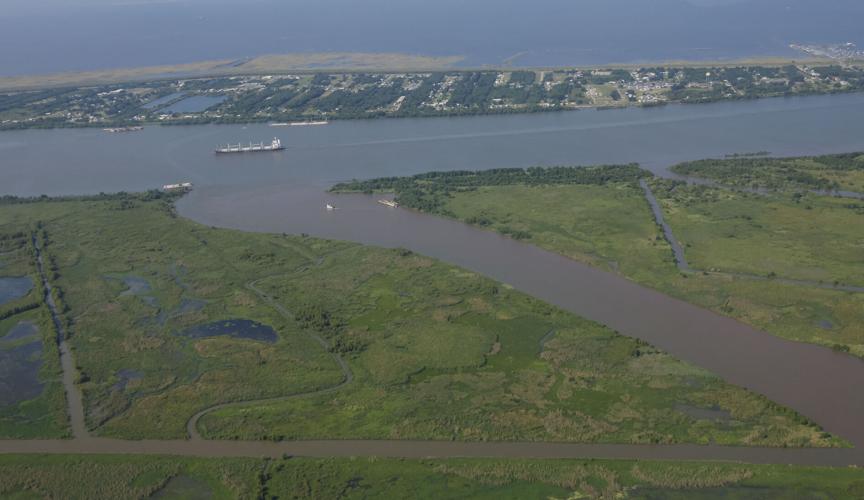A revised plan to limit the growth of a new pass along the Mississippi River south of New Orleans calls for filling its entrance with stone while still allowing some water to flow through to form wetlands – a key demand of coastal advocates.
The Army Corps of Engineers plan for the recently created Neptune Pass would include a stone sill across its entrance to the river, limiting the amount of water flowing into it, while still allowing fishing boats to use it.
It also will include devices to capture sediment entering Quarantine Bay to build wetland terraces. While the flow of water into the pass is affecting shipping, state officials concerned with Louisiana's severe land loss had urged the Corps not to close it completely since it is acting as a natural river diversion and creating wetlands in the process.
An earlier plan called for building a stone structure inside the pass a few hundred yards east of the river to reduce the flow of water. But new computer modeling indicated that during high-river periods, water would flank the structure and erode new paths around it within a few years, Matthew Crawford, an engineer with the Corps' New Orleans District office overseeing the project, told members of the state Coastal Protection and Restoration Authority during its Wednesday meeting in Belle Chasse.

This image shows the plan for building a stepped sill of stone across the mouth of Neptune Pass along the east bank of the Mississippi River. A 100-foot segment in the center would be 26 feet below sea level, with adjacent sections 8 feet below sea level. The portions tying into the existing river banks would be 5 feet above sea level. (Army Corps of Engineers)
A bank failure along the river in 2019 opened the crevasse, which quickly became a new distributary of the river.
The pass widened by 328% in the past four years, Crawford said. By the spring of 2022, 16% of the river's flow at Buras was diverted into the pass.
That July, the Corps deposited 90,000 cubic yards of stone on the southern bank of the new channel where it connected to the river to prevent the remaining bank from failing. This April, additional scouring required more stone to be placed along the east bank of the pass to prevent the opening from enlarging.
The loss of water to the new pass has slowed the flow of water in the river to its south. That's allowed sediment in the water to drop out and cause shoaling in that area for the first time, Crawford said. As a result, the Corps has had to add that area to its annual multi-million-dollar maintenance dredging program.

The Army Corps of Engineers' original plan to reduce water flow in Neptune Pass was to build a sill structure within the pass away from the river. That plan was abandoned because computer modeling indicated that during future high-river years, water would flank the structure and create new eroded paths towards Quarantine Bay. (Army Corps of Engineers)
Crawford said the water exiting the river into the pass also has been pulling ocean-going vessels towards that side of the river.
The new plan would reduce the amount of water exiting the river to stop the shoaling and effects on shipping, while still allowing the pass to carry sediment into areas of the Bird's Foot Delta and Quarantine Bay, where it can build new wetlands.
The sill will be a stepped stone structure tying into existing banklines north and south of the pass opening right at the river's eastern bank that will limit the flow of water into the pass.

This Lidar image of the entrance to Neptune Pass and the adjacent interior of the Mississippi River show how the crevasse forming the pass has expanded, and the threats to the riverbank nearby. (Army Corps of Engineers)
The rock structure will include a notch in its center to allow water to flow into the pass from as deep in the river as 26 feet below sea level. The new design will still allow significant water and sediment to flow into the pass and eventually into Quarantine Bay.
The Corps will build a series of "sediment-retention enhancement devices" -- basically speed bumps -- where the pass enters the bay. Those will slow the water enough to get sediment to drop out. The goal is to form 10 new wetland terraces that become a mini-delta.
As design of the new project is being completed, the Corps also is writing a draft environmental assessment that is scheduled to be released for a 30-day public comment period on April 1.

The Neptune Pass project includes a plan to use hard structures to slow water entering Quarantine Bay to allow sediment to drop out and form new wetland terraces, a mini-delta. (Army Corps of Engineers)
If all goes well, Crawford said, a contract for the project could be awarded by June 15, and construction could begin a month later.
The Corps expects to have an estimate of the cost of the new structure when the environmental assessment is released. It paid $4.2 million in July 2022 for the initial bankline stone armoring and another $2.5 milllion for additional stone armoring in April 2023 to prevent further scouring and enlargement of the channel entrance.









